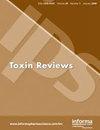印度法里德科特区农业土壤中潜在有毒元素的风险评估和稻米中的生物浓缩
IF 2.4
4区 医学
Q2 TOXICOLOGY
引用次数: 0
摘要
本文章由计算机程序翻译,如有差异,请以英文原文为准。
Risk assessment of potentially toxic elements in agricultural soils and bioconcentration in rice grains from Faridkot District, India
Abstract Potentially toxic elements (PTEs) in soil pose significant risks to both ecology and human health. Therefore, to understand the effect of PTEs in agricultural soils of Faridkot District, Punjab, India, 36 soil samples were analyzed for physicochemical properties, contents of PTEs (aluminum, arsenic, nickel, boron, uranium, barium, chromium, cadmium, copper, iron, lead, cobalt, manganese, selenium, and zinc), possible ecological and human health risks and bioconcentration in rice grains. Soils showed high mean contents (mg/kg) of potassium (906.65), sodium (760.78), and chlorides (247.13) with cadmium, copper, zinc, arsenic, and selenium contents (mg/kg) in 55.56%, 33.33%, 25.00%, 16.67%, and 13.89% of samples exceeding their safe limits (0.06, 20.00, 50.00, 20.00, and 0.20, respectively). Individual and multi-element indices suggested extremely high-soil enrichment of arsenic, cadmium, and selenium and low to moderate ecological risk. Multivariate analyses revealed the contribution of both geogenic and anthropogenic activities to soil contamination. Mean bioconcentration factors of chromium (4.48), boron (1.24), and copper (2.69) were >1.00 in rice. Residents had higher cancer risk (TCR) due to arsenic (3.64E-05) and chromium (4.04E-06) in soil, mainly through ingestion and dermal contact. This work could serve as baseline database for further research and designing the strategy to alleviate soil contamination.
求助全文
通过发布文献求助,成功后即可免费获取论文全文。
去求助
来源期刊

Toxin Reviews
医学-毒理学
CiteScore
6.80
自引率
0.00%
发文量
36
审稿时长
>12 weeks
期刊介绍:
Toxin Reviews provides an international forum for publishing state-of-the-art reviews and guest-edited single topic special issues covering the multidisciplinary research in the area of toxins derived from animals, plants and microorganisms. Our aim is to publish reviews that are of broad interest and importance to the toxinology as well as other life science communities. Toxin Reviews aims to encourage scientists to highlight the contribution of toxins as research tools in deciphering molecular and cellular mechanisms, and as prototypes of therapeutic agents. Reviews should emphasize the role of toxins in enhancing our fundamental understanding of life sciences, protein chemistry, structural biology, pharmacology, clinical toxinology and evolution. Prominence will be given to reviews that propose new ideas or approaches and further the knowledge of toxinology.
 求助内容:
求助内容: 应助结果提醒方式:
应助结果提醒方式:


